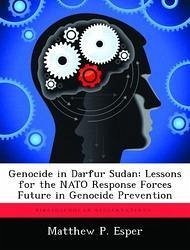Despite the cry of "Never Again", the world community has been incapable of preventing genocide. Between 60 million and 150 million people perished in episodes of mass killing in the twentieth century alone.1 The first genocide of the twenty first century began in Darfur, Sudan and quickly highlighted the international community's inability to stop the killings. Extant data suggests that between 350,000 and 400,000 Darfurian's perished between February 2003 and July 2005, and a recent U.N. mortality assessment indicates more than 6,000 continue to die every month.2 Others report that between 218,000 and 306,000 died between April 2003 and February 2005.3 Regardless of whose numbers you follow, the misery in Darfur has been mind numbing. The African Union has taken the lead on stopping the genocide in Darfur by installing African Union Mission in Sudan (AMIS) forces in the region. However, these forces are not organized, trained or equipped to handle this type of mission, and have been ineffective in stopping the genocide. Absent action or intervention by a better-equipped force, the deeply inadequate African Union force will continue to fail at stopping the genocide. This work has been selected by scholars as being culturally important, and is part of the knowledge base of civilization as we know it. This work was reproduced from the original artifact, and remains as true to the original work as possible. Therefore, you will see the original copyright references, library stamps (as most of these works have been housed in our most important libraries around the world), and other notations in the work. This work is in the public domain in the United States of America, and possibly other nations. Within the United States, you may freely copy and distribute this work, as no entity (individual or corporate) has a copyright on the body of the work. As a reproduction of a historical artifact, this work may contain missing or blurred pages, poor pictures, errant marks, etc. Scholars believe, and we concur, that this work is important enough to be preserved, reproduced, and made generally available to the public. We appreciate your support of the preservation process, and thank you for being an important part of keeping this knowledge alive and relevant.
Bitte wählen Sie Ihr Anliegen aus.
Rechnungen
Retourenschein anfordern
Bestellstatus
Storno








